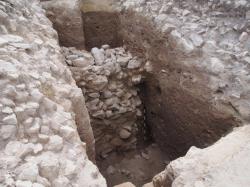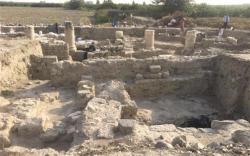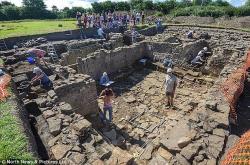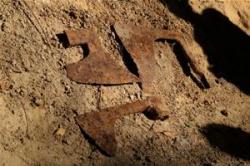INSTITUT SUPERIEUR D'ANTHROPOLOGIE
INSTITUTE OF ANTHROPOLOGY
ONLINE COURSES / COURS A DISTANCE
FALL TERM : OCTOBER 2014
REGISTER NOW
BULGARIE –  Provadia - During this year's excavation in Europe's oldest salt mines near Provadia, eastern Bulgaria, archaeologists discovered a wall from the fifth millennium B.C.E. According to the head of the expedition, Vasil Nikolov, quoted by the Bulgarian National Radio (BNR), the new discovery suggests that mining activities in the area were much more significant than previously thought. “This was a fluke, as many archaeological discoveries are,” Nikolov told BNR. “We found this wall, which in some parts is more than a metre high, but the rest was destroyed by an earthquake. I cannot yet say how tall it really was, but in its base it is more than three metres thick. But there are other walls in the area, which are almost four metres high. Just imagine – this is from the middle of the fifth millennium B.C.E. and there were no fortresses in Europe back then.” During this year's archaeological season in Provadia, were discovered 10 funerals in the necropolis.
Provadia - During this year's excavation in Europe's oldest salt mines near Provadia, eastern Bulgaria, archaeologists discovered a wall from the fifth millennium B.C.E. According to the head of the expedition, Vasil Nikolov, quoted by the Bulgarian National Radio (BNR), the new discovery suggests that mining activities in the area were much more significant than previously thought. “This was a fluke, as many archaeological discoveries are,” Nikolov told BNR. “We found this wall, which in some parts is more than a metre high, but the rest was destroyed by an earthquake. I cannot yet say how tall it really was, but in its base it is more than three metres thick. But there are other walls in the area, which are almost four metres high. Just imagine – this is from the middle of the fifth millennium B.C.E. and there were no fortresses in Europe back then.” During this year's archaeological season in Provadia, were discovered 10 funerals in the necropolis.
http://www.novinite.com/articles/163553/Archaeologists+Uncover+7000-Year-Old+Wall+Near+Provadia
TURQUIE –  Isos -A music chamber has been discovered in a 5,000 year-old ancient city in the eastern province of Hatay’s Erzin neighborhood. It is thought that the chamber, which dates back to the Roman era and which was built with rare “odeon” architecture, was once used for treatment. Excavations have been continuing for eight years in the ancient city of Isos (Epiphane), which was a significant settlement in 545 B.C. The battle between the Macedonian king Alexander the Great and the Persian king Darius took place in this region. Isos is mentioned in history books as a trade city and was a multicultural city where the Roman, Byzantine, late Hittite, Persian and Ottoman empires all settled. A 20-person excavation team, headed by the Hatay Museum archaeologist Ömer Çelik, unearthed some parts of a Roman road in the ancient city this year, revealing that shops at the time were reached through the northeast of the road. Excavations in this area revealed Odean architecture, as well as the music chamber that was discovered. Officials think sick people were treated in this chamber. In addition, excavations in a hill unearthed an amphitheater from the Roman era. The seats of the ancient theater have been so far revealed and currently works are focusing on the theater stage.
Isos -A music chamber has been discovered in a 5,000 year-old ancient city in the eastern province of Hatay’s Erzin neighborhood. It is thought that the chamber, which dates back to the Roman era and which was built with rare “odeon” architecture, was once used for treatment. Excavations have been continuing for eight years in the ancient city of Isos (Epiphane), which was a significant settlement in 545 B.C. The battle between the Macedonian king Alexander the Great and the Persian king Darius took place in this region. Isos is mentioned in history books as a trade city and was a multicultural city where the Roman, Byzantine, late Hittite, Persian and Ottoman empires all settled. A 20-person excavation team, headed by the Hatay Museum archaeologist Ömer Çelik, unearthed some parts of a Roman road in the ancient city this year, revealing that shops at the time were reached through the northeast of the road. Excavations in this area revealed Odean architecture, as well as the music chamber that was discovered. Officials think sick people were treated in this chamber. In addition, excavations in a hill unearthed an amphitheater from the Roman era. The seats of the ancient theater have been so far revealed and currently works are focusing on the theater stage.
http://www.hurriyetdailynews.com/music-chamber-found-in-ancient-city-of-isos.aspx?pageID=238&nid=72076&NewsCatID=375
ROYAUME UNI –  Binchester - One of the most important Roman sites in Britain - dubbed the Pompeii of the North - has been saved after being sold in a £2 million deal. The Auckland Castle Trust bought the Roman Town in Binchester, which hit headlines in the summer after a treasure trove of 1,800-year-old remains and jewellery were uncovered there by archaeologists. Fears had been growing that the site was going to be split after the Church Commissioners who own the land put it up for sale over two separate lots.
Binchester - One of the most important Roman sites in Britain - dubbed the Pompeii of the North - has been saved after being sold in a £2 million deal. The Auckland Castle Trust bought the Roman Town in Binchester, which hit headlines in the summer after a treasure trove of 1,800-year-old remains and jewellery were uncovered there by archaeologists. Fears had been growing that the site was going to be split after the Church Commissioners who own the land put it up for sale over two separate lots.
http://www.dailymail.co.uk/sciencetech/article-2766580/Pompeii-North-saved-Roman-fort-remain-intact-bought-charitable-trust-2-million-deal.html
BULGARIE –  – Dobrich - An archaeological expedition uncovered a church treasure of more than 1200 early Byzantine coins near the Dobrich village of Debrene, said the director of the Dobirch history museum Kostadin Kostadinov. According to the head of the expedition Boyan Totev, this is the first such discovery in Bulgaria. He said the small amphora full of bronze Byzantine coins from the VI c. A.D. was most likely church mite, buried in the ground during an invasion of Slavs or Avars. The discovery was made on the territory of a small fortress, most likely built in late antiquity around a basilica to protect it. The church itself was built during the late Roman empire and existed till the end of VI c. A.D. Archaeologist have found late Roman, early Byzantine and old Bulgarian layers, as well as late Roman artifacts.
– Dobrich - An archaeological expedition uncovered a church treasure of more than 1200 early Byzantine coins near the Dobrich village of Debrene, said the director of the Dobirch history museum Kostadin Kostadinov. According to the head of the expedition Boyan Totev, this is the first such discovery in Bulgaria. He said the small amphora full of bronze Byzantine coins from the VI c. A.D. was most likely church mite, buried in the ground during an invasion of Slavs or Avars. The discovery was made on the territory of a small fortress, most likely built in late antiquity around a basilica to protect it. The church itself was built during the late Roman empire and existed till the end of VI c. A.D. Archaeologist have found late Roman, early Byzantine and old Bulgarian layers, as well as late Roman artifacts.
http://www.novinite.com/articles/163552/Archaeologists+Uncover+Church+Treasure+Near+Dobrich
GRECE –  Amphipolis - The Greek Ministry of Culture announced that the caryatids flanking the second doorway at the Kasta Hill tomb site have been completely uncovered. Standing more than seven feet tall, their well-preserved feet wear kothornoi, or thick-soled shoes, that bear traces of red and yellow paint. According to a report, parts of the statues’ broken hands and arms were recovered from the surrounding soil. The tomb is estimated to be 2,300 years old, and is thought to have been designed by Dinocrates, chief architect to Alexander the Great. It may contain the remains of someone from his inner circle.
Amphipolis - The Greek Ministry of Culture announced that the caryatids flanking the second doorway at the Kasta Hill tomb site have been completely uncovered. Standing more than seven feet tall, their well-preserved feet wear kothornoi, or thick-soled shoes, that bear traces of red and yellow paint. According to a report, parts of the statues’ broken hands and arms were recovered from the surrounding soil. The tomb is estimated to be 2,300 years old, and is thought to have been designed by Dinocrates, chief architect to Alexander the Great. It may contain the remains of someone from his inner circle.
http://www.archaeology.org/news/2536-140922-greece-amphipolis-caryatid-sandals
POLOGNE -  Wipsowo - Three Teutonic battle axes from the late Middle Ages have been found by engineers who remove World War II artillery shells left the forests in the Forest District Wipsowo (Warmia and Mazury). Historic weapons will be donated to the museum. Engineers stumbled upon the historic axes by chance, while searching the woods metal detectors. The weapons have been initially identified by an archaeologist as late-medieval Teutonic battle axes. Iron axes were close to each other, shallow underground, among the roots of trees. "It can be assumed that this is a deposit that someone left for better times. Perhaps the person fled, hid the weapons and never returned to this place" - told PAP Agata Trzop-Szczypiorska, responsible for archaeological supervision of the engineers’ work. According to the archaeologist, clearing the forest of unexploded shells has just begun, so there is hope for more finds. After completion of the work, Teutonic axes will be preserved and donated to the Museum of Warmia and Mazury in Olsztyn.
Wipsowo - Three Teutonic battle axes from the late Middle Ages have been found by engineers who remove World War II artillery shells left the forests in the Forest District Wipsowo (Warmia and Mazury). Historic weapons will be donated to the museum. Engineers stumbled upon the historic axes by chance, while searching the woods metal detectors. The weapons have been initially identified by an archaeologist as late-medieval Teutonic battle axes. Iron axes were close to each other, shallow underground, among the roots of trees. "It can be assumed that this is a deposit that someone left for better times. Perhaps the person fled, hid the weapons and never returned to this place" - told PAP Agata Trzop-Szczypiorska, responsible for archaeological supervision of the engineers’ work. According to the archaeologist, clearing the forest of unexploded shells has just begun, so there is hope for more finds. After completion of the work, Teutonic axes will be preserved and donated to the Museum of Warmia and Mazury in Olsztyn.
http://www.naukawpolsce.pap.pl/en/news/news,401862,engineers-found-teutonic-axes-in-the-forest-district-wipsowo.html